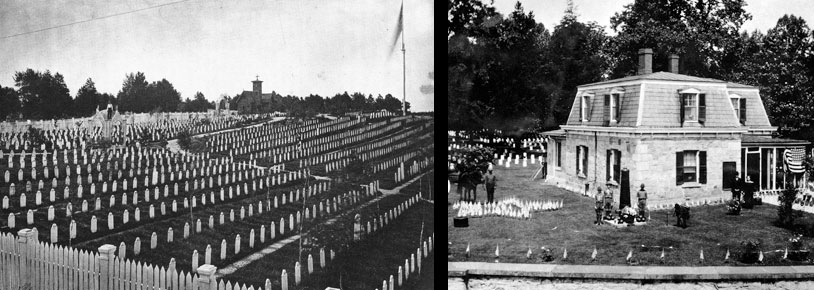

Civil War Era National Cemeteries: Honoring Those Who Served
Cold Harbor National Cemetery
Mechanicsville, Virginia
 |
Superintendent's lodge, Cold Harbor National Cemetery Courtesy of the Department of Veterans Affairs, National Cemetery Administration, History Program |
After a series of fierce battles during the Overland Campaign at the Wilderness, Spotsylvania, North Anna, and Totopotomoy Creek in May 1864, both Union General Ulysses S. Grant and Confederate General Robert E. Lee recognized the strategic importance of Cold Harbor, a crossroads between Richmond and the Chickahominy River, named for a local tavern. After skirmishing on May 31 and June 1, Grant planned an assault on the Confederate lines for June 2, but his men were exhausted, forcing him to postpone the engagement. This gave Lee’s men time to fortify their defensive trenches and allowed additional reinforcements to arrive.
When the Union charge finally began before dawn on June 3, the Confederates, though outnumbered 100,000 to 60,000, were able to hold their positions, cutting down Union troops until “the dead covered more than five acres of ground about as thickly as they could be laid.” The battle became Lee’s last major victory and one of Grant’s greatest regrets. Recounting the battle's failed assault, Grant wrote in his memoirs, "At Cold Harbor no advantage whatever was gained to compensate for the heavy loss we sustained." The Union suffered over 12,000 casualties, while the Confederates suffered only 4,000.
To accommodate the massive number of Union soldiers who died in the area, Cold Harbor National Cemetery was established in 1866. The first burials in the cemetery were reinterments of Union soldiers from across a 22-square mile area, including the battlefields of Cold Harbor, Gaines’ Mill, Savage’s Station, and Mechanicsville. More than 1,300 burials are unknown, including two large burial mounds at the north end of the cemetery containing the remains of 889 unknown soldiers. The cemetery closed to new interments in 1970.
 |
| The Pennsylvania Monument Courtesy of the Department of Veterans Affairs, National Cemetery Administration, History Program |
The square-shaped, 1.4-acre cemetery has four sections. Marked by iron gates and accessible only to pedestrians, the main entrance is along the cemetery’s southern edge. Built according to the Quartermaster Corps standardized plan, the Second Empire style superintendent’s lodge that Meigs designed circa 1870 is near the main entrance. A four-foot tall brick wall encloses the grounds.
There are three large monuments in the modest-size cemetery. The Pennsylvania Monument, erected in 1909 by the Commonwealth of Pennsylvania, honors the state’s volunteer soldiers who died at the Battle of Cold Harbor. A soldier standing at parade rest is atop the 30 foot-tall granite shaft, which architect J. Henry Brown designed. The base of the shaft lists the regiments that participated in the battle.
The Tomb of the Unknown Soldier, erected in 1877 by the Federal Government, is a marble sarcophagus that memorializes the 889 unknown Union soldiers interred in two large group burials at the cemetery. A monument to the 8th New York Artillery Regiment, erected in 1909 by the state of New York, consists of an 11 foot-tall granite block with a bronze dedication tablet affixed to the front.
Cold Harbor National Cemetery is the final resting place for a recipient of the Medal of Honor, the nation’s highest military decoration, given for “conspicuous gallantry and intrepidity at the risk of his life above and beyond the call of duty.”
| Plan your visit |
Cold Harbor National Cemetery is located at 6038 Cold Harbor Rd., in Mechanicsville, VA. The cemetery is open for visitation daily from dawn to dusk. No cemetery staff is present onsite. The administrative office is located at the Hampton National Cemetery, Hampton, and the office is open Monday to Friday from 8:00am to 4:30pm; it is closed on all Federal holidays except for Memorial Day and Veterans Day. For more information, please contact the cemetery office at 757-723-7104, or see the Department of Veterans Affairs website. While visiting, please be mindful that our national cemeteries are hallowed ground. Be respectful to all of our nation’s fallen soldiers and their families. Additional cemetery policies may be posted on site. Richmond National Battlefield Park preserves several battlefields and historic sites related to the 1862 Peninsula Campaign and the 1864 Overland Campaign around the former Confederate capital. Cold Harbor National Cemetery is one of seven national cemeteries in the Richmond area. The others include Fort Harrison, Glendale, and Richmond National Cemeteries in Richmond; Seven Pines National Cemetery in Sandston; City Point National Cemetery in Hopewell; and Poplar Grove National Cemetery in Petersburg. Cold Harbor National Cemetery was photographed to the standards established by the National Park Service’s Historic American Landscapes Survey. The nearby Gathwright House, which was used as a field hospital during the Civil War, has been documented by the National Park Service’s Historic American Buildings Survey. |